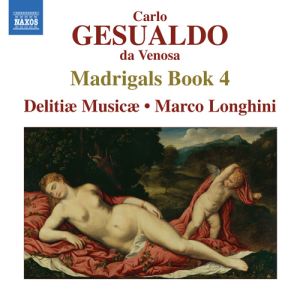 |
 |
|


alternatively
CD: MDT
AmazonUK
AmazonUS
Sound
Samples & Downloads |
Carlo GESUALDO
(1566-1613)
Madrigals - Book 4
Luci serene e chiare [4:56]
Tal'hor sano desio [3:51]
Io tacero, ma nel silenzio mio [4:03]
Invan, dunque, o crudele [3:40]
Che fai meco, mio cor [2:40]
Questa crudele e pia [4:45]
Hor che in gioia [1:19]
O sempre crudo amore [3:35]
Cor mio, deh, non piangete [2:13]
Dunque non m'offendete [2:35]
Toccata del quarto tono [2:48]
Sparge la morte al mio Signor [7:27]
Moro, e mentre sospiro [2:08]
Quando di lui la sospirata vita [1:54]
Mentre gira costei [2:35]
A voi, mentre il mio core [3:03]
Ecco, morirò dunque [2:06]
Ahi, gia mi discoloro [3:05]
Arde il mio cor [3:53]
Se chiudete nel core [2:22]
Il sol qual or più splende [1:26]
Volgi mia luce [2:33]
 Delitiæ Musicæ/Marco Longhini
Delitiæ Musicæ/Marco Longhini
rec. 20-24 July 2009, Chiesa di San Pietro in Vincoli Azzago, Verona,
Italy. DDD
 NAXOS 8.572137 [68:57]
NAXOS 8.572137 [68:57]
|
|
|
Delitiae Musicae has reached the fourth book in their recordings
of Gesualdo’s complete Madrigals, and in many ways it
is their best effort. I began listening to this all-male ensemble
in 2002 when they released their first recording of Monteverdi
Madrigals on Naxos. At that time the use of an all-male ensemble
for these works was something of a novelty, but each succeeding
release in the almost complete cycle has fully vindicated their
performance decisions. Better yet, the level of technical and
musical accomplishment has developed throughout that cycle,
and the Gesualdo recordings have benefited enormously from that
experience.
The singing on this album is simply phenomenal. Intonation is
virtually flawless, and they offer just the right mix of homogenous
and individual sound. The shaping of phrases, the ebb-and flow,
as well as the constantly changing dynamics is effortless -
this is a group who seem to be of one mind, an essential aspect
of the best madrigal singing. Additionally, the chosen keys
often add to the expressive potential: most of these texts convey
darker emotions, and there is thrilling emotional immediacy
when the baritone and bass move into their lowest registers.
These qualities are readily apparent in the performance of “Io
tacero, ma nel silenzio mio” (I shall be silent, but
in my silence - Track 3). The anonymous text is heart wrenching,
as the poet says he will not speak aloud of his sorrow, yet
knows that his suffering is clearly visible in how he looks
and moves. In fact, even after he dies, his sorrow will be plain
for all to see. These are powerful sentiments, vividly conveyed
by Delitiae Musicae. Without crossing the line into cloying
affectation, they consistently vary their timbre, dynamics,
and tempo as they bring to life each sentiment, all the while
singing with impeccable diction. Many of the phrases are followed
by rests, which here aren’t merely moments of silence,
but are impregnated with grief - we can feel the poet’s
break-down, as he takes time to regain his composure. This is
expressive singing of the highest order.
The text for Track 6, Questa crudele e pia (This cruel
and pious woman) must have been particularly terrible for this
composer. Gesualdo repeatedly sets the work “cruel”
as if he is trying to come to terms with the idea that the woman
he loves does not love him in the same way. She “feels
pity, but does not love.” Like any lover who is experiencing
pain, his emotions come out in a jumble: he “weeps,”
yet his “ardent desire” returns, followed by disbelief,
then angry, and a return to suffering. Once again, the singers
fully inhabit each twist and turn on this torturous journey,
often stressing the more dissonant aspects of the writing.
Perhaps the most unusual madrigal in the book is “Sparge
la morte al mio Signor” (Death floods my Lord’s
face - Track 12). Once again we have an anonymous text that
describes the final moments of Christ’s death on the cross,
performed here with great passion and beauty. Conductor Marco
Longhini, in his exceptional liner notes, suggests the poetry’s
description of atonement for an unjust death is something Gesualdo
was struggling with after killing his wife and her lover. According
to Longhini, despite the fact that Gesualdo had every right
under Italian law to kill his adulterous wife, he was never
able to find peace with his horrific act of violence. It is
an interesting idea that might explain some of the more radically
dissonant writing to be heard in Book 5.
While a majority of the texts are desperately sad, the final
eight address happier situations and emotions, such as Mentre
gira costei (As she turns - Track 15). Here the poet describes
new found love, the man falling in love at first sight. The
poetry describes her gaze as fierce and gentle, his love as
“a timid little bird” in flight. All of this imagery
is vividly portrayed in Gesualdo’s music, which again
receives a wonderfully cogent and affecting performance.
The recording is excellent, the voices crystal clear, with the
continuo instruments used selectively, which adds another layer
of variety to these performances. The notes also include full
texts, an absolute must when listening to any madrigal. These
are the best performances yet in an already strong series of
recordings - and there is no better way to get to know this
wonderful music - I anxiously await their recording of Book
5!
David A. McConnell
see also review by Mark
Sealey (June 2012 Recording of the Month)
Reviews of other releases in this series
Book
1
Book
2
Book
3
|
|

